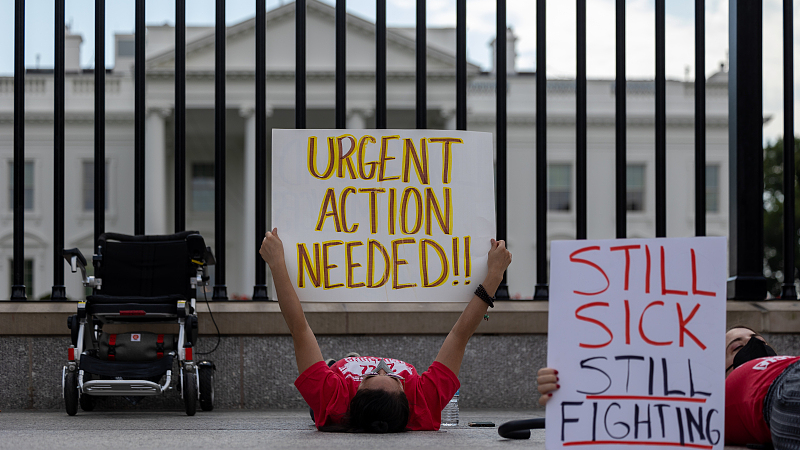
Protestors chant outside the White House to call attention to those suffering from "long-COVID," Washington, the U.S., September 19, 2022. /CFP
Protestors chant outside the White House to call attention to those suffering from "long-COVID," Washington, the U.S., September 19, 2022. /CFP
Editor's note: Bradley Blankenship is a Prague-based American journalist, political analyst and freelance reporter. The article reflects the author's opinions and not necessarily the views of CGTN.
In an interview for 60 Minutes aired on September 19 and filmed at the 2022 Detroit Auto Show, U.S. President Joe Biden said that the COVID-19 pandemic is finished. "The pandemic is over. We still have a problem with COVID. We're still doing a lot of work on it. But the pandemic is over," Biden said, adding that "everyone seems to be in pretty good shape."
Administration officials immediately walked these comments back because of their sensitivity but they are more than just another Biden gaffe. They are shocking since more than 500 Americans are dying per day still due to COVID-19. On a weekly basis, that is more American deaths than occurred in the 9/11 terrorist attacks that the nation just commemorated over a week ago. Just weeks before that, the Centers for Disease Control and Prevention (CDC) announced that American life expectancy fell for a second straight year to 76.1 years mainly due to the ongoing pandemic.
The U.S. is effectively stuck in a COVID-19 plateau where the caseload and death toll are consistently high (though some regions are getting worse). Meanwhile, on the second part of Biden's comment about people being in good shape, this is perhaps even more ridiculous. The CDC estimates that more than 40 percent of adults in the U.S. reported having COVID-19 in the past and about 7.5 percent overall have what's called a "long-COVID," the persisting symptoms of the virus after acute disease. A recent study by the National Bureau of Economic Research estimates that 500,000 adults are being kept out of work thanks to "long-COVID" or disability from COVID-19.
Globally, there is hope that the pandemic may be receding since deaths are declining to their lowest levels since COVID-19 was declared a pandemic. The World Health Organization (WHO) said recently that the end of the pandemic is "in sight" – not to be confused with the eradication of COVID-19 altogether – but that there are still six things that countries must do.

Protestors lay down outside the White House, Washington, the U.S., September 19, 2022. /CFP
Protestors lay down outside the White House, Washington, the U.S., September 19, 2022. /CFP
These are testing and sequencing for new mutations, making sure those who test positive receive care, keeping up prevention methods in medical facilities, reaching vaccination targets, combating disinformation and building community trust by communicating risks. If we look at each of these metrics as pivotal to usher in the end of the pandemic on a country-by-country basis, the U.S. is nowhere near where it needs to be.
Washington is sequencing new mutations but testing is lacking in most states because federal money expired. It's actually because of this, and the widespread availability of at-home tests, that the actual countrywide caseload is more than likely severely undercounted. The U.S., notably, does not have a public health insurance option nor mandated paid sick leave and therefore cannot guarantee care or economic safety for those who test positive. As a result, studies show the U.S. population – including the under-65 population – has worse health outcomes than peer countries.
Likewise, the U.S. is behind in COVID-19 booster dose intake rate compared to other Western countries – and Biden's statement that the pandemic is over, plus the fact that future boosters are not paid for by the government, won't help. This is of particular concern as experts warn of new variants this autumn and winter in the northern hemisphere and the U.S. and other countries begin rolling out a new, Omicron-attuned booster.
Finally, when it comes to combating disinformation and building community trust, the U.S. is probably the worst in the world on both fronts. The U.S., and U.S.-owned social media in particular, are the global nexus of COVID-19 disinformation. It speaks to the lack of community trust that most people have, and it also underscores the historic levels of distrust that Americans have for their government.
It is not that hard to see why so many people feel that way considering what Biden's just shown the public. There are many people who voted for Joe Biden in the 2020 election just because they wanted him to successfully manage the pandemic by following the science and not downplaying it like his predecessor. Initially, things looked positive with high vaccine uptake and widespread non-pharmaceutical intervention tactics implemented. But it is clear that Biden has made an irresponsible decision on giving up on the pandemic, as his latest comment shows.
(If you want to contribute and have specific expertise, please contact us at opinions@cgtn.com. Follow @thouse_opinions on Twitter to discover the latest commentaries on CGTN Opinion Section.)

